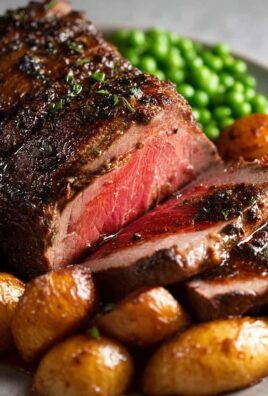Thai Basil Chicken, or Pad Kra Pao Gai, is a dish that explodes with flavor in every single bite! Imagine tender, juicy ground chicken stir-fried with fragrant Thai basil, fiery chilies, and a savory sauce that clings to every morsel. Are you ready to experience a culinary adventure that’s both incredibly delicious and surprisingly easy to make at home?
This iconic dish hails from the streets of Thailand, where it’s a beloved staple found in bustling markets and humble eateries alike. While the exact origins are debated, Pad Kra Pao is a relatively modern creation, gaining popularity in the latter half of the 20th century. It quickly became a favorite due to its bold flavors and satisfying simplicity.
What makes Thai Basil Chicken so irresistible? It’s the perfect balance of sweet, savory, spicy, and umami. The fresh Thai basil lends a unique anise-like aroma that elevates the dish beyond ordinary stir-fries. People adore it for its quick cooking time, making it an ideal weeknight meal. Plus, the customizable spice level allows everyone to tailor it to their own preferences. Whether you’re a seasoned Thai food enthusiast or a curious beginner, this recipe is guaranteed to become a new favorite!
Ingredients:
- 2 tablespoons vegetable oil
- 1 pound ground chicken
- 4 cloves garlic, minced
- 1 red bell pepper, seeded and thinly sliced
- 1 small onion, thinly sliced
- 1-2 Thai chilies, finely chopped (adjust to your spice preference)
- 1/4 cup chicken broth
- 2 tablespoons soy sauce
- 1 tablespoon oyster sauce
- 1 tablespoon fish sauce
- 1 tablespoon dark soy sauce (for color, optional)
- 1 teaspoon sugar
- 1 cup fresh Thai basil leaves
- Cooked rice, for serving
- Fried egg (optional), for serving
- Lime wedges, for serving
Preparing the Chicken and Aromatics
- First, let’s get our ingredients prepped. Mince the garlic. I like to use a garlic press for this, but finely chopping it works just as well. The key is to get it nice and small so it releases its flavor quickly in the hot oil.
- Next, thinly slice the red bell pepper and onion. Uniform slices will ensure even cooking. I usually aim for about 1/4-inch thick slices.
- Now, for the chilies! This is where you can really customize the heat level. If you like it mild, use just one chili or even half. If you’re a spice fiend like me, go for two! Remember to wash your hands thoroughly after handling chilies, and avoid touching your eyes. Finely chop the chilies.
- Finally, measure out all your sauces and sugar into a small bowl and whisk them together. This will make it easier to add them to the pan later and ensures everything is evenly distributed. This mixture will include the chicken broth, soy sauce, oyster sauce, fish sauce, dark soy sauce (if using), and sugar. Set this sauce mixture aside.
Cooking the Thai Basil Chicken
- Heat the vegetable oil in a large skillet or wok over medium-high heat. You want the oil to be shimmering hot before adding the chicken. A wok is ideal because of its sloped sides, which make it easy to toss the ingredients, but a large skillet will work just fine.
- Add the ground chicken to the hot skillet. Break it up with a spatula and cook until it’s browned and cooked through. This usually takes about 5-7 minutes. Make sure to stir it frequently to prevent it from sticking and to ensure even cooking. You want to break the chicken into small pieces as it cooks.
- Once the chicken is browned, push it to one side of the skillet and add the minced garlic, sliced red bell pepper, and sliced onion to the empty space. Sauté these aromatics for about 2-3 minutes, or until the onion is translucent and the garlic is fragrant. Be careful not to burn the garlic, as it can become bitter.
- Now, add the chopped Thai chilies to the skillet and stir them in with the garlic, bell pepper, and onion. Cook for another minute to release their flavor.
- Pour the sauce mixture (chicken broth, soy sauce, oyster sauce, fish sauce, dark soy sauce, and sugar) over the chicken and vegetables. Stir everything together well to combine.
- Bring the sauce to a simmer and let it cook for about 2-3 minutes, or until it has thickened slightly. This will allow the flavors to meld together and create a delicious, savory sauce.
- Remove the skillet from the heat and stir in the fresh Thai basil leaves. The basil will wilt quickly from the heat. Stir until the basil is just wilted, as overcooking it can make it bitter.
Serving Suggestions
- Serve the Thai basil chicken immediately over cooked rice. Jasmine rice is a classic choice, but any type of rice will work well.
- For an extra touch, top the rice and chicken with a fried egg. The runny yolk adds richness and flavor to the dish.
- Garnish with lime wedges. A squeeze of fresh lime juice brightens up the flavors and adds a zesty touch.
Tips and Variations
- Spice Level: Adjust the amount of Thai chilies to your preference. For a milder dish, remove the seeds from the chilies before chopping them.
- Protein: You can substitute ground chicken with ground pork, ground beef, or even tofu. If using tofu, press it first to remove excess water.
- Vegetables: Feel free to add other vegetables to the dish, such as green beans, mushrooms, or carrots.
- Dark Soy Sauce: Dark soy sauce is optional, but it adds a richer color and slightly sweeter flavor to the dish. If you don’t have it, you can omit it or substitute it with a little bit of molasses.
- Fish Sauce: Fish sauce is a key ingredient in Thai cuisine, but if you don’t have it, you can substitute it with a little bit of soy sauce or Worcestershire sauce.
- Fresh Basil: Using fresh Thai basil is essential for the authentic flavor of this dish. If you can’t find Thai basil, you can substitute it with regular basil, but the flavor will be slightly different.
- Make it Vegetarian/Vegan: Substitute the ground chicken with firm tofu (pressed and cubed). Use vegetarian oyster sauce or omit it altogether, increasing the soy sauce slightly. Ensure your fish sauce substitute is also vegetarian/vegan.
- Meal Prep: This dish is great for meal prepping! Store the cooked chicken and rice separately in airtight containers in the refrigerator for up to 3-4 days. Reheat in the microwave or on the stovetop. Add the fresh basil just before serving.
- Freezing: You can freeze the cooked chicken for up to 2-3 months. Thaw it in the refrigerator overnight before reheating. The texture of the basil may change slightly after freezing, so it’s best to add fresh basil after reheating.
- Serving with Noodles: Instead of rice, try serving the Thai basil chicken with noodles. Rice noodles or egg noodles would both be delicious.
- Adding a Sweet Element: For a touch of sweetness, consider adding a small drizzle of honey or maple syrup to the sauce. Start with a teaspoon and adjust to your liking.
- Thickening the Sauce: If you prefer a thicker sauce, you can mix a teaspoon of cornstarch with a tablespoon of cold water and add it to the skillet during the last minute of cooking. Stir until the sauce thickens.
- Using a Wok: If you have a wok, definitely use it! The shape of the wok allows for even heat distribution and makes it easy to toss the ingredients.
- Don’t Overcrowd the Pan: If you’re making a large batch, it’s best to cook the chicken in batches to avoid overcrowding the pan. Overcrowding can lower the temperature of the pan and result in the chicken steaming instead of browning.
- Taste as You Go: The most important tip is to taste as you go and adjust the seasonings to your liking. Add more soy sauce for saltiness, more sugar for sweetness, or more chilies for heat.
Detailed Ingredient Notes
Ground Chicken:
I prefer using ground chicken with a lower fat content (around 93% lean) to avoid excess grease in the dish. However, you can use ground chicken with a higher fat content if you prefer. Just be sure to drain off any excess grease after cooking the chicken.
Garlic:
Fresh garlic is always best for this recipe. I recommend using about 4 cloves, but you can adjust the amount to your liking. If you don’t have fresh garlic, you can use garlic powder, but the flavor won’t be quite as intense. Use about 1 teaspoon of garlic powder for every 2 cloves of fresh garlic.
Red Bell Pepper:
Red bell pepper adds a touch of sweetness and color to the dish. You can substitute it with other colors of bell pepper, such as green or yellow, but the flavor will be slightly different.
Onion:
I prefer using a yellow onion for this recipe, but you can also use a white onion or a red onion. Red onions have a slightly stronger flavor than yellow or white onions.
Thai Chilies:
Thai chilies are very spicy, so use them sparingly if you’re not a fan of heat. You can substitute them with other types of chilies, such as jalapenos or serranos, but the flavor will be slightly different. Remember to remove the seeds from the chilies before chopping them to reduce the heat.
Chicken Broth:
Chicken broth adds moisture and flavor to the sauce. You can substitute it with vegetable broth or water if you don’t have chicken broth on hand.
Conclusion:
This Thai Basil Chicken recipe isn’t just another weeknight dinner; it’s a vibrant explosion of flavor that will transport your taste buds straight to the bustling streets of Bangkok. The fragrant basil, the fiery chilies, and the savory sauce combine to create a dish that’s both comforting and exciting. It’s quick, it’s easy, and it’s guaranteed to become a new favorite in your household. I truly believe that once you try this, you’ll be making it again and again!
But why is this recipe a must-try? Beyond the incredible taste, it’s the versatility that really shines. You can easily adjust the spice level to suit your preference add more chilies for an extra kick, or omit them altogether for a milder flavor. The recipe is also incredibly adaptable to different dietary needs. Use ground turkey or tofu instead of chicken for a lighter or vegetarian option. You can even swap out the white rice for brown rice, quinoa, or cauliflower rice for a healthier twist.
Speaking of serving suggestions, the possibilities are endless! I personally love serving this Thai Basil Chicken over a bed of fluffy jasmine rice, topped with a fried egg for extra richness. The runny yolk adds a wonderful creaminess that complements the savory sauce perfectly. You could also serve it with a side of steamed vegetables, such as broccoli, bok choy, or green beans, to add some extra nutrients to your meal. Another great option is to serve it in lettuce wraps for a light and refreshing appetizer or snack.
For variations, consider adding other vegetables to the stir-fry. Bell peppers, onions, mushrooms, and carrots all work beautifully in this dish. You could also experiment with different types of basil. While Thai basil is the traditional choice, holy basil or even regular sweet basil can be used in a pinch. Just be aware that the flavor profile will be slightly different. Another fun variation is to add a splash of coconut milk to the sauce for a creamier and more decadent dish. This will also help to mellow out the spice if you’re sensitive to heat.
I’ve poured my heart into perfecting this recipe, and I’m confident that you’ll love it as much as I do. It’s a simple yet satisfying meal that’s perfect for busy weeknights or lazy weekends. The aroma alone is enough to make your mouth water, and the taste is simply divine.
So, what are you waiting for? Gather your ingredients, fire up your wok, and get ready to experience the magic of Thai Basil Chicken! I’m so excited for you to try this recipe and discover your own favorite variations.
And now for the most important part: I want to hear from you! Once you’ve made this recipe, please come back and share your experience in the comments below. Let me know what you thought of the flavor, what variations you tried, and any tips or tricks you discovered along the way. Your feedback is invaluable, and it helps me to continue creating delicious and accessible recipes for you to enjoy. Don’t be shy share your culinary adventures with the world! Happy cooking!
Thai Basil Chicken: A Delicious & Easy Recipe
Quick and flavorful Thai Basil Chicken (Pad Kra Pao Gai) made with ground chicken, fresh basil, and a savory sauce. Serve over rice for a delicious weeknight meal.
Ingredients
- 2 tablespoons vegetable oil
- 1 pound ground chicken
- 4 cloves garlic, minced
- 1 red bell pepper, seeded and thinly sliced
- 1 small onion, thinly sliced
- 1-2 Thai chilies, finely chopped (adjust to your spice preference)
- 1/4 cup chicken broth
- 2 tablespoons soy sauce
- 1 tablespoon oyster sauce
- 1 tablespoon fish sauce
- 1 tablespoon dark soy sauce (for color, optional)
- 1 teaspoon sugar
- 1 cup fresh Thai basil leaves
- Cooked rice, for serving
- Fried egg (optional), for serving
- Lime wedges, for serving
Instructions
- Prepare Ingredients: Mince garlic, thinly slice red bell pepper and onion, and finely chop Thai chilies. Whisk together chicken broth, soy sauce, oyster sauce, fish sauce, dark soy sauce (if using), and sugar in a small bowl.
- Cook Chicken: Heat vegetable oil in a large skillet or wok over medium-high heat. Add ground chicken and break it up with a spatula. Cook until browned and cooked through (5-7 minutes), stirring frequently.
- Sauté Aromatics: Push chicken to one side of the skillet. Add minced garlic, sliced red bell pepper, and sliced onion to the empty space. Sauté for 2-3 minutes, until onion is translucent and garlic is fragrant.
- Add Chilies and Sauce: Add chopped Thai chilies to the skillet and stir with the garlic, bell pepper, and onion. Cook for another minute. Pour the sauce mixture over the chicken and vegetables. Stir well to combine.
- Simmer and Thicken: Bring the sauce to a simmer and cook for 2-3 minutes, until it has thickened slightly.
- Add Basil: Remove from heat and stir in fresh Thai basil leaves until just wilted.
- Serve: Serve immediately over cooked rice. Top with a fried egg (optional) and garnish with lime wedges.
Notes
- Spice Level: Adjust the amount of Thai chilies to your preference. For a milder dish, remove the seeds from the chilies before chopping them.
- Protein: You can substitute ground chicken with ground pork, ground beef, or even tofu. If using tofu, press it first to remove excess water.
- Vegetables: Feel free to add other vegetables to the dish, such as green beans, mushrooms, or carrots.
- Dark Soy Sauce: Dark soy sauce is optional, but it adds a richer color and slightly sweeter flavor to the dish. If you don’t have it, you can omit it or substitute it with a little bit of molasses.
- Fish Sauce: Fish sauce is a key ingredient in Thai cuisine, but if you don’t have it, you can substitute it with a little bit of soy sauce or Worcestershire sauce.
- Fresh Basil: Using fresh Thai basil is essential for the authentic flavor of this dish. If you can’t find Thai basil, you can substitute it with regular basil, but the flavor will be slightly different.
- Make it Vegetarian/Vegan: Substitute the ground chicken with firm tofu (pressed and cubed). Use vegetarian oyster sauce or omit it altogether, increasing the soy sauce slightly. Ensure your fish sauce substitute is also vegetarian/vegan.
- Meal Prep: This dish is great for meal prepping! Store the cooked chicken and rice separately in airtight containers in the refrigerator for up to 3-4 days. Reheat in the microwave or on the stovetop. Add the fresh basil just before serving.
- Freezing: You can freeze the cooked chicken for up to 2-3 months. Thaw it in the refrigerator overnight before reheating. The texture of the basil may change slightly after freezing, so it’s best to add fresh basil after reheating.
- Serving with Noodles: Instead of rice, try serving the Thai basil chicken with noodles. Rice noodles or egg noodles would both be delicious.
- Adding a Sweet Element: For a touch of sweetness, consider adding a small drizzle of honey or maple syrup to the sauce. Start with a teaspoon and adjust to your liking.
- Thickening the Sauce: If you prefer a thicker sauce, you can mix a teaspoon of cornstarch with a tablespoon of cold water and add it to the skillet during the last minute of cooking. Stir until the sauce thickens.
- Using a Wok: If you have a wok, definitely use it! The shape of the wok allows for even heat distribution and makes it easy to toss the ingredients.
- Don’t Overcrowd the Pan: If you’re making a large batch, it’s best to cook the chicken in batches to avoid overcrowding the pan. Overcrowding can lower the temperature of the pan and result in the chicken steaming instead of browning.
- Taste as You Go: The most important tip is to taste as you go and adjust the seasonings to your liking. Add more soy sauce for saltiness, more sugar for sweetness, or more chilies for heat.




